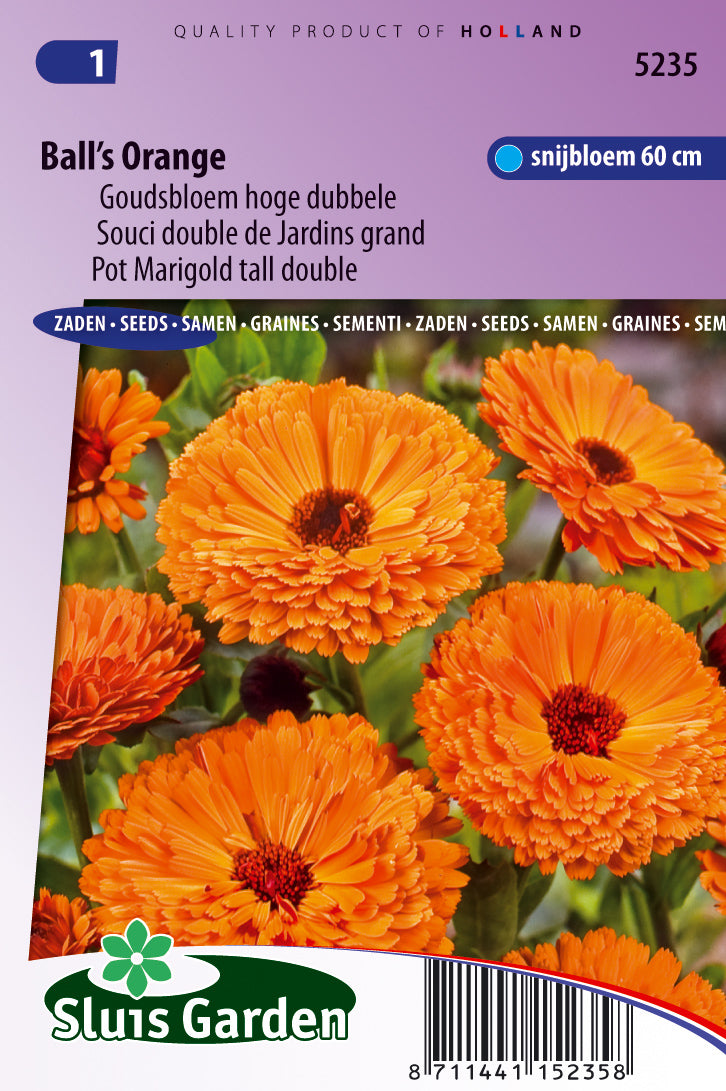1
/
of
1
Calendula Ball’s Orange
Calendula Ball’s Orange
Regular price
1.250 KWD
Regular price
Sale price
1.250 KWD
Unit price
/
per
Shipping calculated at checkout.
Couldn't load pickup availability
Calendula Ball's Orange is a variety known for its beautiful orange flowers. Here's a guide on how to grow Calendula Ball's Orange:
**1. Planting Time:**
- Calendula can be directly sown outdoors or started indoors. Sow seeds directly in the garden after the last frost date in spring. If starting indoors, begin seeds 4-6 weeks before the last expected frost.
**2. Soil Preparation:**
- Choose well-draining soil with a neutral to slightly alkaline pH. Calendula is not too picky about soil types but prefers moderately fertile soil. Incorporate organic matter, such as compost, to improve soil structure.
**3. Sunlight:**
- Calendula prefers full sun but can tolerate partial shade. Ensure they receive at least 6 hours of sunlight daily for optimal flowering.
**4. Planting Seeds:**
- Sow Calendula Ball's Orange seeds about 1/4 inch deep in well-prepared soil. Space the seeds according to the guidelines on the seed packet.
**5. Watering:**
- Keep the soil consistently moist, especially during the germination period. Once established, Calendula is somewhat drought-tolerant. Water at the base of the plants to prevent wetting the foliage.
**6. Mulching:**
- Apply a layer of mulch around the plants to help retain soil moisture and suppress weeds. Mulching also helps keep the soil temperature more consistent.
**7. Fertilization:**
- Calendula doesn't require heavy fertilization. A balanced, all-purpose fertilizer applied at the time of planting is usually sufficient.
**8. Deadheading:**
- Deadhead spent flowers regularly to encourage continuous blooming. This also prevents the plant from putting energy into seed production.
**9. Companion Planting:**
- Calendula is known to have pest-repelling properties and can be beneficial when planted near vegetables. It attracts pollinators like bees and butterflies.
**10. Pruning:**
- Pinch back the growing tips when the plants are about 6 inches tall to encourage bushier growth and more blooms.
**11. Disease and Pest Control:**
- Calendula is generally resistant to pests and diseases. Keep an eye out for aphids or spider mites, and treat them promptly if detected.
**12. Harvesting:**
- Harvest Calendula Ball's Orange flowers when they are fully open. Use them fresh or dry them for later use in teas, salves, or potpourris.
**13. Overwintering:**
- In mild climates, Calendula may self-seed and come back the following year. In colder climates, it's often grown as an annual, and you can collect seeds for replanting.
**14. Organic Certification:**
- If you wish to officially label your Calendula Ball's Orange as organic, follow the guidelines and requirements set by your local organic certification body.
Growing Calendula Ball's Orange can add a burst of orange color and beauty to your garden. Following these guidelines will help you cultivate healthy and vibrant Calendula plants.
**1. Planting Time:**
- Calendula can be directly sown outdoors or started indoors. Sow seeds directly in the garden after the last frost date in spring. If starting indoors, begin seeds 4-6 weeks before the last expected frost.
**2. Soil Preparation:**
- Choose well-draining soil with a neutral to slightly alkaline pH. Calendula is not too picky about soil types but prefers moderately fertile soil. Incorporate organic matter, such as compost, to improve soil structure.
**3. Sunlight:**
- Calendula prefers full sun but can tolerate partial shade. Ensure they receive at least 6 hours of sunlight daily for optimal flowering.
**4. Planting Seeds:**
- Sow Calendula Ball's Orange seeds about 1/4 inch deep in well-prepared soil. Space the seeds according to the guidelines on the seed packet.
**5. Watering:**
- Keep the soil consistently moist, especially during the germination period. Once established, Calendula is somewhat drought-tolerant. Water at the base of the plants to prevent wetting the foliage.
**6. Mulching:**
- Apply a layer of mulch around the plants to help retain soil moisture and suppress weeds. Mulching also helps keep the soil temperature more consistent.
**7. Fertilization:**
- Calendula doesn't require heavy fertilization. A balanced, all-purpose fertilizer applied at the time of planting is usually sufficient.
**8. Deadheading:**
- Deadhead spent flowers regularly to encourage continuous blooming. This also prevents the plant from putting energy into seed production.
**9. Companion Planting:**
- Calendula is known to have pest-repelling properties and can be beneficial when planted near vegetables. It attracts pollinators like bees and butterflies.
**10. Pruning:**
- Pinch back the growing tips when the plants are about 6 inches tall to encourage bushier growth and more blooms.
**11. Disease and Pest Control:**
- Calendula is generally resistant to pests and diseases. Keep an eye out for aphids or spider mites, and treat them promptly if detected.
**12. Harvesting:**
- Harvest Calendula Ball's Orange flowers when they are fully open. Use them fresh or dry them for later use in teas, salves, or potpourris.
**13. Overwintering:**
- In mild climates, Calendula may self-seed and come back the following year. In colder climates, it's often grown as an annual, and you can collect seeds for replanting.
**14. Organic Certification:**
- If you wish to officially label your Calendula Ball's Orange as organic, follow the guidelines and requirements set by your local organic certification body.
Growing Calendula Ball's Orange can add a burst of orange color and beauty to your garden. Following these guidelines will help you cultivate healthy and vibrant Calendula plants.

